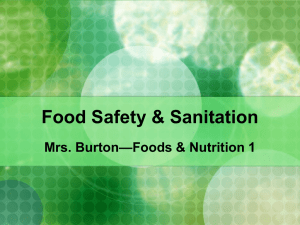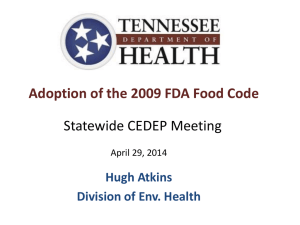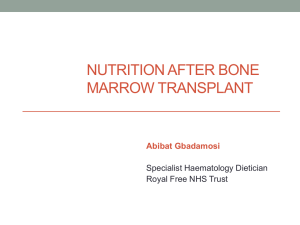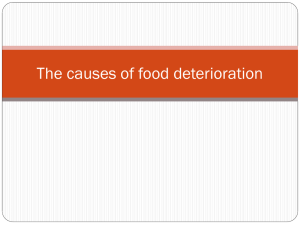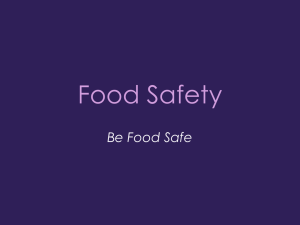Please click here for Kitchen Safety Powerpoint
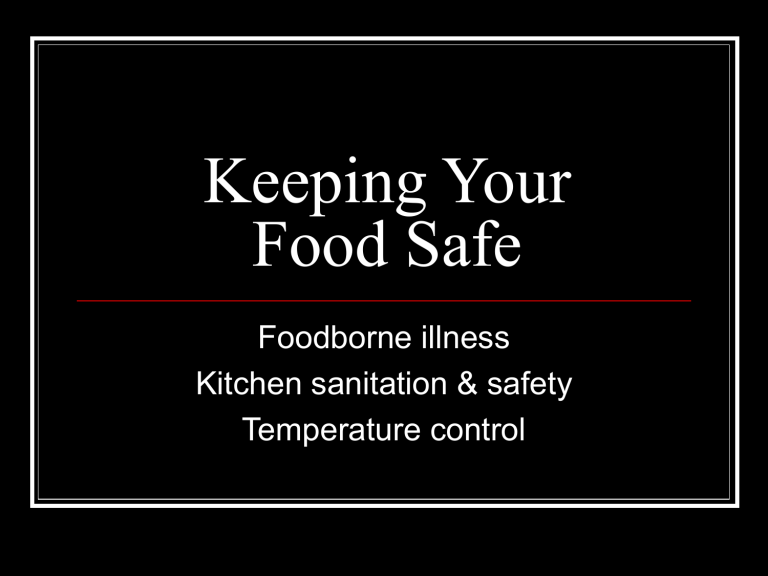
Keeping Your
Food Safe
Foodborne illness
Kitchen sanitation & safety
Temperature control
Foodborne illness
Any sickness resulting from eating unsafe food
Can be mild or even fatal
Most are caused by microorganisms —tiny microscopic organisms including bacteria, parasites and viruses
Many of these are helpful and used (in small amounts) in the making of foods like yogurt or vinegar, but others or too much of them can make us sick
Contamination of foods
Occurs when harmful bacteria get into food and multiply to dangerous amounts
In order for this to occur, the right temperature, food, and moisture must be present
The danger zone for contamination occurs between 40 and 140 F
That is why it is important to keep hot foods hot and cold foods cold; to prevent bacteria growth and contamination
Symptoms of foodborne illness:
Occur from 30 minutes to 2 weeks after eating contaminated food —usually 4 to 48 hrs.
General symptoms include nausea, vomiting, diarrhea, abdominal pain. Sometimes cases are severe and need immediate attention
Who is at risk?
Those with weakened immune systems are most at risk —the elderly, pregnant women, infants and young children
Anyone can be a victim of foodborne illness
What should you do if you suspect foodborne illness?
Rest and drink plenty of fluids
Call the local health department and make a report if:
The food came from a restaurant
The food was prepacked from a store
It was eaten at a large gathering and others might be sick
To prevent foodborne illness —
Keep foods at the correct temperature
Destroy bacteria through proper cooking
Prevent the spread of microorganisms
Shopping for food safely
To protect yourself during food shopping:
Check freshness dates on packages
Choose canned goods without rust, dents, or bulging
Keep raw meats and poultry separate from other foods
Be sure packages are unopened
Be sure refrigerated and frozen foods look like they should —not like they have been left out
Select foods that should be cold last during your shopping trip
Storing food safely
Dry storage occurs in a cabinet or somewhere dry and dark
Never store foods under the sink or next to a heat source
Store foods away from cleaning products
Good things to store here are cereals, crackers, canned foods, dry beans, pasta vegetable oil, peanut butter
Rotate your supply by putting the new purchases behind the older ones in the cabinet
Storing food safely, continued
Refrigerator storage —between 32-40
Store perishable fruits, vegetables, dairy, eggs, meats, poultry, leftovers
Keep foods in airtight containers
Wipe up spills immediately
Discard spoiled foods
Use door shelves for condiments that are not as perishable as other items
Storing food safely, continued
Freezer storage —0 or less
Store any frozen foods as well as foods that keep longer if they are frozen, such as meats or breads
Wrap foods tightly to avoid freezer burn
Label foods with the date and the name of the food
Rotate your supply to use oldest foods first
How long will it keep?
Changes can happen to food over time that make food taste differently or lose nutrients
Many changes can also make your foods harmful
Never eat foods that:
Come from leaking or bulging cans, or from cracked jars
Come from containers that spurt liquid when opened
Is slimy, mushy, discolored, or does not look or smell right
Leftovers older than four days
Any food you are unsure of
On hard cheeses, mold can be cut away at least 1” around the moldy area, then the food can be re-wrapped and stored
Keeping it Clean!
To prevent contamination of food wash hands:
Before food preparation
After handling raw food
After using the toilet or changing a diaper
After touching pets
After touching your mouth, nose, hair or other body parts while handling food
More cleanliness
Don’t handle food if you have symptoms of illnesses
Tie back long hair before preparing
Wear clean clothing
Cover any cuts or sores on your hand with kitchen gloves
Don’t sneeze or cough over food
Keeping your kitchen clean
Regularly clean surfaces and appliances
Clean up as you go
Use paper towels to reduce the spread of germs
Keep dirty dishes away from food preparation areas
Always use clean dishes and utensils
Wipe the top of canned foods before using
Avoid cross contamination
Occurs when harmful bacteria are transferred from one food to another. This can happen easily when using raw meats, poultry & fish
To prevent:
Use separate cutting boards & knives for meats, poultry or fish and another for other foods
Be cautious of the juices from these foods
Wash everything that comes in contact with these foods
Use non-porous cutting boards (not wood) with these foods
Never place ready to eat food on a plate that held raw foods
To thaw foods safely, don’t set out on the counter.
In the refrigerator
Place frozen foods in a plastic bag on the lowest shelf.
Allow a day or two to thaw
In cold water
Place frozen item in sink or large bowl with cold water, change the water frequently. This is a little quicker than the refrigerator.
In the microwave
Place in a microwave safe container and use the defrost setting. Check frequently so it doesn’t begin cooking
Cooking foods thoroughly
The best judge is a thermometer
Food
Beef, veal, lamb, pork
Internal temperature
160; well done is 170
Ground poultry, breast thighs, roasts 170
Whole chicken or turkey
Fish
180
145
Serving food safely
Keep hot foods hot; above 140
Keep cold foods cold; below 40
Perishable foods should not be allowed to set more than 2 hours
Preventing Kitchen Accidents
Be careful of loose clothing, jewelry or long hair around fire and appliances
To prevent cuts:
Store knives in a block or special drawer
Don’t soak knives in a sink where they might not be seen
Use a cutting board
Clean up broken glass carefully & immediately
To prevent electrical shock
Keep all electricity away from water
Keep electrical cords away from heat sources
Unplug appliances before cleaning
Do not overload an outlet with too many appliances
To prevent falls
Keep cabinet doors closed
Wipe up spills immediately
Use a sturdy stool to reach tall things
To prevent burns and fires
Watch foods while they are cooking on the stove
Keep a fire extinguisher handy
Store flammable items and aerosol cans away from heat
Turn handles of pots towards the inside of the range
Keep potholders close to the range
Lift the lid of a hot pan away from your face, not towards it
Do not try to clean a hot stove
To prevent poisoning
Store household chemicals away from food and where children cannot reach them
Follow label directions when using
Never store in an unmarked container
Handling Emergencies
keep a first aid kit and fire extinguisher handy
Know CPR and the Heimich maneuver
Stay calm
Call for help if you need it
Have emergency numbers close to the phone
Kitchen fires
Turn off the heat source
Cover the pan, or pour salt or baking soda on the flames —NEVER WATER
Disconnect the appliance

